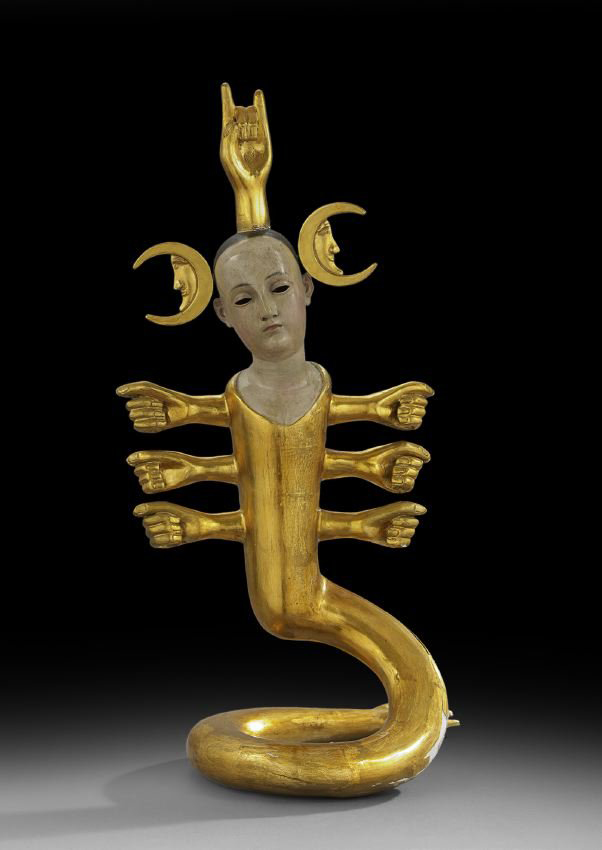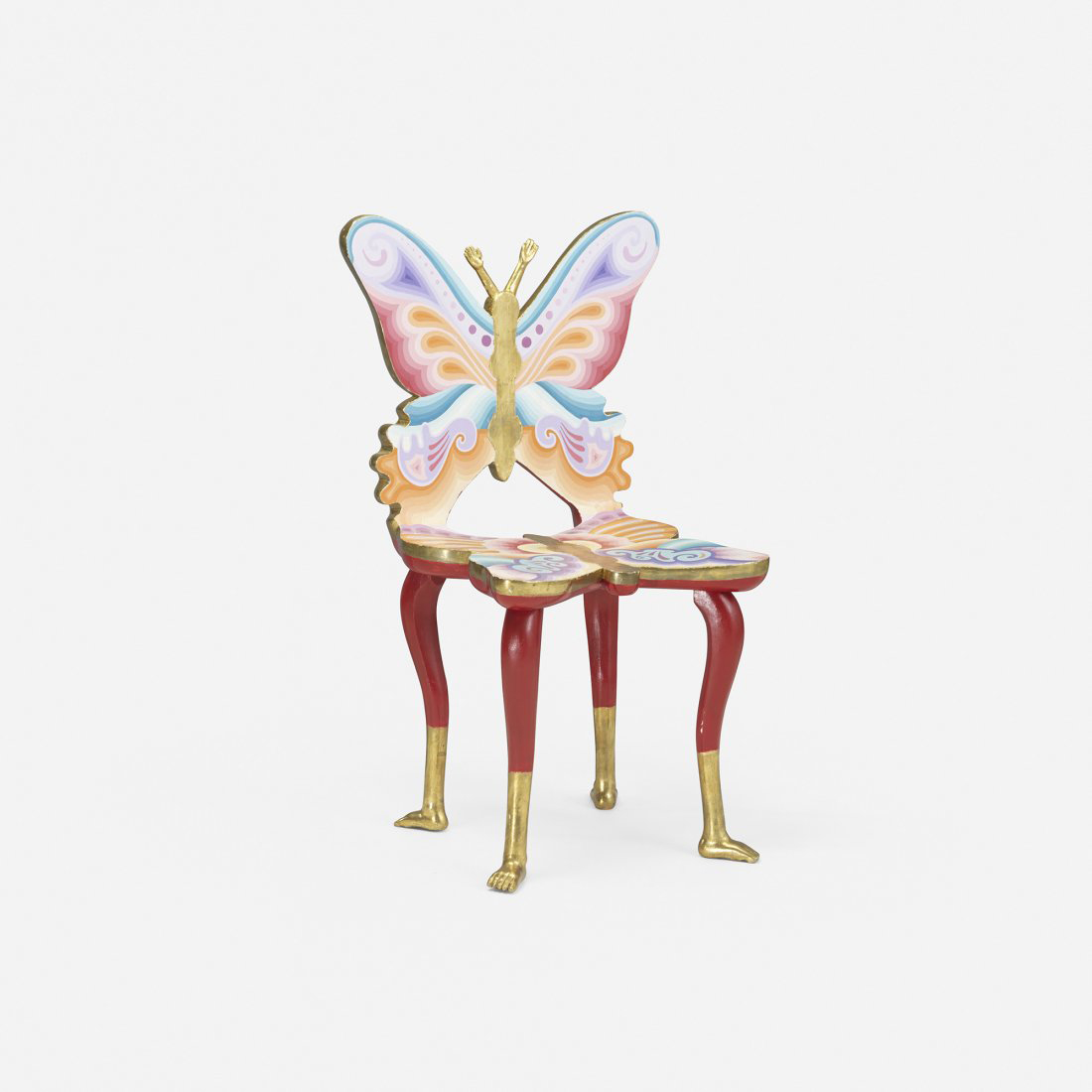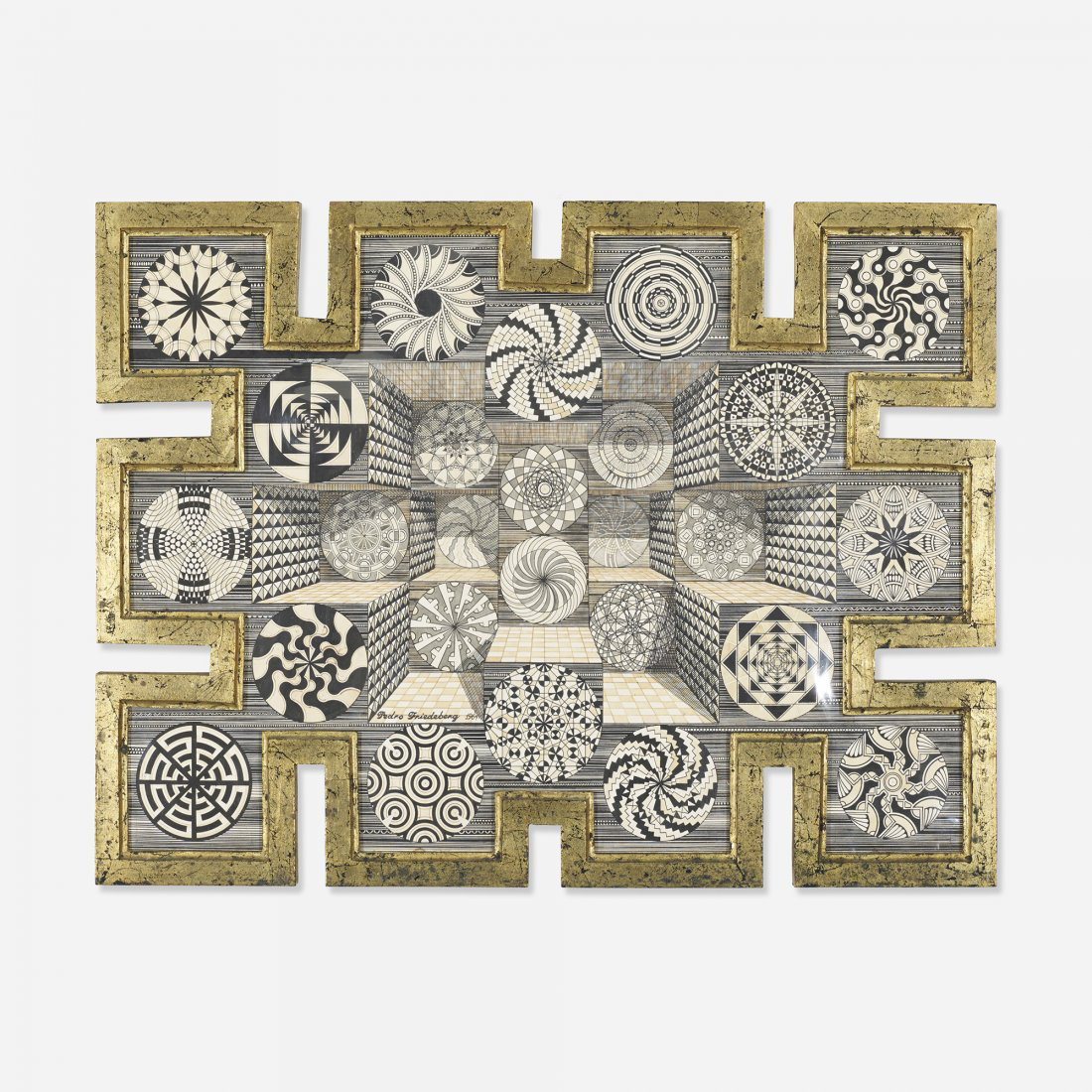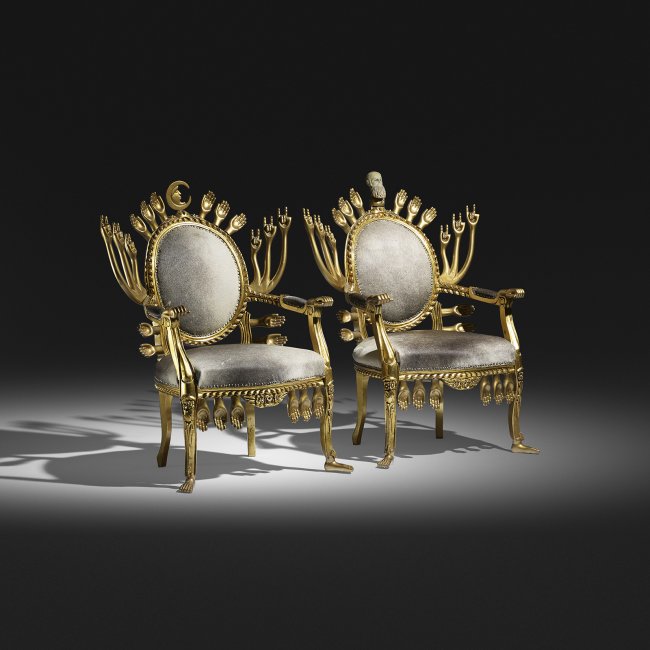[av_slideshow_full size=’no scaling’ stretch=” animation=’fade’ autoplay=’false’ interval=’5′ control_layout=’av-control-default’ src=” attachment=” attachment_size=” position=’top left’ repeat=’no-repeat’ attach=’scroll’]
[av_slide_full slide_type=’image’ id=’60105′ video=” mobile_image=” video_format=” video_ratio=” title=’Pedro Friedeberg:
Flights of Fantasy ‘ custom_title_size=’48’ custom_content_size=’20’ caption_pos=’caption_center’ link_apply=” link=’lightbox’ link_target=” button_label=” button_color=’light’ link1=’manually,http://’ link_target1=” button_label2=” button_color2=’light’ link2=’manually,http://’ link_target2=” font_color=’custom’ custom_title=’#ffffff’ custom_content=’#020202′ overlay_enable=’aviaTBaviaTBoverlay_enable’ overlay_opacity=’0.1′ overlay_color=’#444444′ overlay_pattern=” overlay_custom_pattern=”]
BY KARLA KLEIN ALBERTSON
[/av_slide_full]
[/av_slideshow_full]
[av_textblock size=” font_color=’custom’ color=’#ffffff’]
Friedeberg’s signature sculpture is the hand chair, often supported by a single or – in this case – triple foot. This signed pair, carved from Mexican walnut in 2007 and acquired by the owner from the artist, sold for $33,020 at Wright in Chicago last June.
[/av_textblock]
[av_section min_height=” min_height_px=’500px’ padding=’default’ shadow=’no-border-styling’ bottom_border=’no-border-styling’ id=” color=’main_color’ custom_bg=’#f2f2f2′ src=” attachment=” attachment_size=” attach=’scroll’ position=’top left’ repeat=’no-repeat’ video=” video_ratio=’16:9′ overlay_opacity=’0.5′ overlay_color=” overlay_pattern=” overlay_custom_pattern=”]
[av_one_full first min_height=” vertical_alignment=’av-align-top’ space=” margin=’0px’ margin_sync=’true’ padding=’10px,20px,10px,20px’ border=’1′ border_color=’#eaeaea’ radius=’0px’ radius_sync=’true’ background_color=’#ffffff’ src=” attachment=” attachment_size=” background_position=’top left’ background_repeat=’no-repeat’]
[av_hr class=’invisible’ height=’30’ shadow=’no-shadow’ position=’center’ custom_border=’av-border-thin’ custom_width=’50px’ custom_border_color=” custom_margin_top=’30px’ custom_margin_bottom=’30px’ icon_select=’yes’ custom_icon_color=” icon=’ue808′ font=’entypo-fontello’]
[av_textblock size=” font_color=” color=”]
In our dreams, what we know, what we have read and what we can imagine fuse into symbolic narratives. Everyone can dream, but it is the rare artist who can translate his compelling visions into a form others can share.
[/av_textblock]
[av_hr class=’invisible’ height=’30’ shadow=’no-shadow’ position=’center’ custom_border=’av-border-thin’ custom_width=’50px’ custom_border_color=” custom_margin_top=’30px’ custom_margin_bottom=’30px’ icon_select=’yes’ custom_icon_color=” icon=’ue808′ font=’entypo-fontello’]
[av_textblock size=’16’ font_color=’custom’ color=’#686868′]
Pedro Friedeberg (b. 1936), known best for his sculptural furniture and intricate drawings, has spent a lifetime creating visionary works for others to enjoy. His productions are often humorous on the surface, but they reveal a foundation of serious thought under the exuberance of spontaneous creativity.
Friedeberg has lived most of his life in Mexico, where his German-Jewish parents settled after leaving Italy just before World War II began. In a light-hearted biography on his eponymous website, he writes, “I was born in Italy during the era of Mussolini, who made all trains run on time. Immediately thereafter, I moved to Mexico where the trains are never on time, but where once they start moving they pass pyramids.”
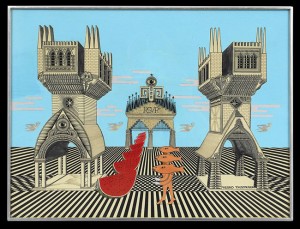 As a young man, he studied architecture at the Universidad Iberoamericana, a Jesuit foundation in Mexico City. Although this seemed like a good career choice to his family, Friedeberg found he had no affinity for the box-like architectural styles in vogue at the time. He did, however, meet Mathias Goeritz (1915-1990), another artist with German roots living in Mexico, who had a significant influence on the younger man.
As a young man, he studied architecture at the Universidad Iberoamericana, a Jesuit foundation in Mexico City. Although this seemed like a good career choice to his family, Friedeberg found he had no affinity for the box-like architectural styles in vogue at the time. He did, however, meet Mathias Goeritz (1915-1990), another artist with German roots living in Mexico, who had a significant influence on the younger man.
Still in his early 20s, Friedeberg began having one-man art shows at Mexican galleries. His paintings and drawings still were strongly architectural in composition. In July 2014, the web magazine designboom published an in-depth studio interview with the artist, who is now in his late 70s. In response to a question about how his work evolved, he said, “Originally I would have lots of little people in my work, but it was Goeritz who told me to leave them out and just paint architecture and geometry. He was right in the sense that it looked more modern that way, he was modern and he wanted me to be that way too.” He added, “Who knows what one does or why? I think of my work as a pastiche. There’s a little bit of everything I like in there, a bit of Piranesi, a bit of Beardsley, a bit of Escher – just as you can see with my studio – it’s a very eclectic mix. I appreciate a lot of different things.”
The surrealistic architectural drawing (below) is mysteriously titled Nietzsche’s Last Picnic – note watermelon slices and walking fish. The signed and dated oil, pen and ink on board from 1969 brought $3,939 last summer at New Orleans Auction Galleries.
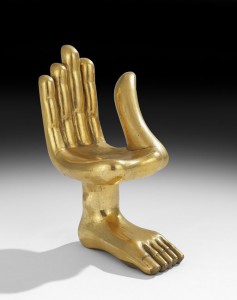 Pedro Friedeberg, however, is most famous today for his three-dimensional sculpture and what might be called fantasy furniture, especially for the universally recognized hand chair. According to the artist, he met master carpenter Jose Gonzalez through Goeritz in 1961. After the craftsman had made a coffee table with human legs based on the artist’s drawing, Friedeberg explained in the same interview, “The next idea that came to my head was the hand as a chair and so he made that for me, that was the first hand chair.” The design was an immediate and perpetual success, a fact that the artist both celebrates and regrets because it has overshadowed his other works.
Pedro Friedeberg, however, is most famous today for his three-dimensional sculpture and what might be called fantasy furniture, especially for the universally recognized hand chair. According to the artist, he met master carpenter Jose Gonzalez through Goeritz in 1961. After the craftsman had made a coffee table with human legs based on the artist’s drawing, Friedeberg explained in the same interview, “The next idea that came to my head was the hand as a chair and so he made that for me, that was the first hand chair.” The design was an immediate and perpetual success, a fact that the artist both celebrates and regrets because it has overshadowed his other works.
Nevertheless, Friedeberg carves hands and feet of all sizes. A gilded example (below) is a tabletop sculpture, 7 1/2 inches high, and doubled its high estimate to bring $2,952 recently in New Orleans.
Friedeberg quickly developed an international reputation. After early shows in Mexico City, his work traveled to galleries in the United States, Canada, Spain, Portugal, France, Germany and Israel during the 1960s and 1970s. A montage of press clippings shows vintage photos of the artist – often accompanied by his hand or butterfly chairs – in fashion or design publications. Friedeberg had developed a flamboyant, eccentric public persona, almost as a private joke – but these antics put him in the news.
One of the most colorful Friedeberg sculptures is the fanciful Butterfly Chair (below). This 1983 example – carved, gilt and hand-painted Mexican mahogany – brought $5,080 at Wright two years ago.
The artist received well-deserved academic attention five years ago when his first major retrospective “Pedro Friedeberg” went on display at the Museo del Palacio de Bellas Artes in Mexico City, Oct. 21, 2009-Jan. 31, 2010. The show presented 185 artworks and supplementary materials including paintings, works on paper, sculpture and furniture on loan from public and private collections and from Friedeberg himself.
An example of Friedeberg’s work on paper, titled I told you so, was done in ink in 1964. The pinwheel composition, presented in the artist’s gilt frame, sold last year at Wright for $5,937.
At the time of the exhibition’s opening, Melissa Feldman wrote a notice titled Hands On in the New York Times on Oct. 2, 2009, which emphasized the hand chair’s perennial appeal to celebrities and style critics. She said, “James Oles – an art historian who is the curator of the exhibition – describes Friedeberg’s art as ‘fusing late Surrealism with Op and Pop Art,’ while the artist himself cites the trompe l’oeil heads of Giuseppe Arcimboldo and the lithographs and woodcuts of M.C. Escher as inspirations.” The fully bilingual exhibition catalog, Pedro Friedeberg, edited by Déborah Holtz and Juan Carlos Mena, texts by curator James Oles and Jeffrey Collins (Mexico City: Trilce Ediciones, 2009) is the essential reference for collectors who would like delve deeper into the development of the artist’s prolific career and the influences that steered its direction. Collins, who is professor and chair of academic programs at the Bard Graduate Center in New York City, contributed the essay A través de la ventana: Pedro Friedeberg y la arquitectura sublime / Through the Window: Pedro Friedeberg’s Sublime Architecture. Oles divides his time between Mexico City and Wellesley College in Massachusetts, where he is senior lecturer in art and adjunct curator of Latin American Art at the Davis Museum.
[/av_textblock]
[av_hr class=’invisible’ height=’50’ shadow=’no-shadow’ position=’center’ custom_border=’av-border-thin’ custom_width=’50px’ custom_border_color=” custom_margin_top=’30px’ custom_margin_bottom=’30px’ icon_select=’yes’ custom_icon_color=” icon=’ue808′ font=’entypo-fontello’]
[av_heading tag=’h3′ padding=’10’ heading=’“I think of my work as a pastiche. There’s a little bit of everything I like in there, a bit of Piranesi, a bit of Beardsley, a bit of Escher…”’ color=” style=’blockquote classic-quote’ custom_font=” size=’44’ subheading_active=” subheading_size=’15’ custom_class=”][/av_heading]
[av_hr class=’invisible’ height=’50’ shadow=’no-shadow’ position=’center’ custom_border=’av-border-thin’ custom_width=’50px’ custom_border_color=” custom_margin_top=’30px’ custom_margin_bottom=’30px’ icon_select=’yes’ custom_icon_color=” icon=’ue808′ font=’entypo-fontello’]
[av_textblock size=’16’ font_color=’custom’ color=’#686868′]
In an interview with Auction Central News, Oles said, “One of the things that I tried to emphasis in this book and in the exhibition is that Friedeberg is someone whose images are very funny. They tap into that side of the surrealist movement in which humor was liberating and could make you think just as much as seriousness. Jokes can often expose important issues. In the 1960s and 1970s, he was a bad boy and raconteur and he was very prolific and hung out with an international jet set. A lot of people did not take him seriously, and he did not act serious or necessarily want to be taken seriously, at a time when many artists in Mexico and elsewhere took themselves extremely seriously.”
“He was in everything, and his hand chair in particular was collected by people across the United States and Europe,” continued Oles. “On the one hand, Friedeberg for many years acted the fool and seemed to just be making fancy things for rich people and he played that. But I argue, as do the fellow authors in the book, that he was one of the most well-read and certainly one of the most brilliant artists of his generation. He speaks and reads several languages fluently. He traveled everywhere, he knows the history of architecture, he knows the history of art backwards and forwards; he knows the history of magic, the history of philosophy, and the history of literature. So this is coming out of an extraordinary intellectual framework as well a framework of his family, which was a very intellectual family in Mexico City.”
“A lot of his work has profound social commentary, particularly about architecture, commercialism, the banality of modern design where everybody wants the exact same chair and it’s kind of lifeless. He disliked modern apartment buildings that are just repetitive, soulless – the humorless aspect of modern architecture and modern design. Very early, in the early 1960s, he was being extremely critical of that. So he’s not only an intellectual, but he was a pioneer in what we would today call postmodernism. The questioning of the fact that modern architecture was some sort of culmination or pinnacle of world civilization. Friedeberg was already questioning that, laughing at that in 1961. So this is an extraordinarily brilliant man with more critical ideas and – in a way – political ideas than his ‘more serious’ colleagues. But unfortunately people have forgotten the intellectual side and remember the comic side instead.”
Richard Wright has sold many examples of Friedeberg’s furniture, sculpture, and drawings in his Chicago design auctions. In a recent interview, he said, “I’ve handled the works for a long time. For me, the very classic hand chairs have always been very popular.” A pair of hand chairs on a triple foot support brought $33,020 in June 2014. He noted that while these chairs are stylish and amusing, other sculptures have darker, more inexplicable themes and symbols. Just as dreams are never easy to solve, some of the artist’s sculptures require deeper contemplation.
Mystical symbolism is ever-present in Friedeberg’s sculpture, where he repeats favorite motifs including various hand gestures and the crescent moon. A 30-inch-high saint-headed serpent topped with a hand warding off the Evil Eye (below) brought $11,377 in 2013.
Wright continued, “His paintings are fascinating. I think of him as very much as a late surrealist with a sort of psychedelic or pop art influence, which is filtered through the iconography of the Catholic Church and the traditions of Mexico – all of these meld together in his work. From my perspective, I find that a piece or two adds a fantastic touch to the mix in a modernist interior. I love that surrealistic note and decorative quality that his work has. Sometimes the sculptures are covered in gold leaf or bright color. A whole interior would be kind of crazy, but it’s really chic stuff in small doses.”
An ample dose is a pair of gilded armchairs (below) upholstered in hide, which were acquired directly from the artist in 1963 – part of a fantasy parlor suite. The classic 18th century shapes embellished with Friedeberg’s hands, a crescent moon, and classical bust brought $20,320 at Wright in December.
The good news for collectors is that Friedeberg has always seemed compelled to create, and intriguing examples turn up at sales throughout North America. At New Orleans Auction Galleries, art specialist Michele Corolla said, “We get them because he’s been very popular in New Orleans. Every once in a while, we’ll get an estate or we’ll get a collector who has one or two pieces. There’s just something about his craft and the whimsy – combined with his talent in working in mixed media – that appeals to people here. It’s as if he has his own private artistic language.”
[/av_textblock]
[/av_one_full]
[/av_section]
[av_one_full first min_height=” vertical_alignment=’av-align-top’ space=” margin=’0px’ margin_sync=’true’ padding=’80px,40px,80px,40px’ border=’1′ border_color=’#eaeaea’ radius=’0px’ radius_sync=’true’ background_color=’#ffffff’ src=” attachment=” attachment_size=” background_position=’top left’ background_repeat=’no-repeat’]
[av_textblock size=” font_color=” color=”]
 About Karla Klein Albertson
About Karla Klein Albertson
Karla Klein Albertson focuses on the decorative arts, from excavated antiquities to contemporary pop-culture icons. She currently writes the Ceramics Collector column and exhibition features for Auction Central News, covers shows and auctions for the Maine Antique Digest, and authors the Antiques column in The Philadelphia Inquirer. She holds a master’s degree in classical archaeology from Bryn Mawr College.
[/av_textblock]
[/av_one_full]
[av_hr class=’invisible’ height=’50’ shadow=’no-shadow’ position=’center’ custom_border=’av-border-thin’ custom_width=’50px’ custom_border_color=” custom_margin_top=’30px’ custom_margin_bottom=’30px’ icon_select=’yes’ custom_icon_color=” icon=’ue808′ font=’entypo-fontello’]
[av_one_fifth first min_height=” vertical_alignment=” space=” custom_margin=” margin=’0px’ padding=’0px’ border=” border_color=” radius=’0px’ background_color=” src=” background_position=’top left’ background_repeat=’no-repeat’][/av_one_fifth]
[av_four_fifth min_height=” vertical_alignment=” space=” custom_margin=” margin=’0px’ padding=’0px’ border=” border_color=” radius=’0px’ background_color=” src=” background_position=’top left’ background_repeat=’no-repeat’]
[av_sidebar widget_area=’SCM – 728×90 – footer’]
[/av_four_fifth]
[av_slideshow_full size=’no scaling’ stretch=” animation=’fade’ autoplay=’false’ interval=’5′ control_layout=’av-control-default’ src=” attachment=” attachment_size=” position=’top left’ repeat=’no-repeat’ attach=’scroll’]
[av_slide_full slide_type=’image’ id=’60105′ video=” mobile_image=” video_format=” video_ratio=” title=’Pedro Friedeberg:
Flights of Fantasy ‘ custom_title_size=’48’ custom_content_size=’20’ caption_pos=’caption_center’ link_apply=” link=’lightbox’ link_target=” button_label=” button_color=’light’ link1=’manually,http://’ link_target1=” button_label2=” button_color2=’light’ link2=’manually,http://’ link_target2=” font_color=’custom’ custom_title=’#ffffff’ custom_content=’#020202′ overlay_enable=’aviaTBaviaTBoverlay_enable’ overlay_opacity=’0.1′ overlay_color=’#444444′ overlay_pattern=” overlay_custom_pattern=”]
BY KARLA KLEIN ALBERTSON
[/av_slide_full]
[/av_slideshow_full]
[av_textblock size=” font_color=’custom’ color=’#ffffff’]
Friedeberg’s signature sculpture is the hand chair, often supported by a single or – in this case – triple foot. This signed pair, carved from Mexican walnut in 2007 and acquired by the owner from the artist, sold for $33,020 at Wright in Chicago last June.
[/av_textblock]
[av_section min_height=” min_height_px=’500px’ padding=’default’ shadow=’no-border-styling’ bottom_border=’no-border-styling’ id=” color=’main_color’ custom_bg=’#f2f2f2′ src=” attachment=” attachment_size=” attach=’scroll’ position=’top left’ repeat=’no-repeat’ video=” video_ratio=’16:9′ overlay_opacity=’0.5′ overlay_color=” overlay_pattern=” overlay_custom_pattern=”]
[av_one_full first min_height=” vertical_alignment=’av-align-top’ space=” margin=’0px’ margin_sync=’true’ padding=’10px,20px,10px,20px’ border=’1′ border_color=’#eaeaea’ radius=’0px’ radius_sync=’true’ background_color=’#ffffff’ src=” attachment=” attachment_size=” background_position=’top left’ background_repeat=’no-repeat’]
[av_hr class=’invisible’ height=’30’ shadow=’no-shadow’ position=’center’ custom_border=’av-border-thin’ custom_width=’50px’ custom_border_color=” custom_margin_top=’30px’ custom_margin_bottom=’30px’ icon_select=’yes’ custom_icon_color=” icon=’ue808′ font=’entypo-fontello’]
[av_textblock size=” font_color=” color=”]
In our dreams, what we know, what we have read and what we can imagine fuse into symbolic narratives. Everyone can dream, but it is the rare artist who can translate his compelling visions into a form others can share.
[/av_textblock]
[av_hr class=’invisible’ height=’30’ shadow=’no-shadow’ position=’center’ custom_border=’av-border-thin’ custom_width=’50px’ custom_border_color=” custom_margin_top=’30px’ custom_margin_bottom=’30px’ icon_select=’yes’ custom_icon_color=” icon=’ue808′ font=’entypo-fontello’]
[av_textblock size=’16’ font_color=’custom’ color=’#686868′]
Pedro Friedeberg (b. 1936), known best for his sculptural furniture and intricate drawings, has spent a lifetime creating visionary works for others to enjoy. His productions are often humorous on the surface, but they reveal a foundation of serious thought under the exuberance of spontaneous creativity.
Friedeberg has lived most of his life in Mexico, where his German-Jewish parents settled after leaving Italy just before World War II began. In a light-hearted biography on his eponymous website, he writes, “I was born in Italy during the era of Mussolini, who made all trains run on time. Immediately thereafter, I moved to Mexico where the trains are never on time, but where once they start moving they pass pyramids.”
 As a young man, he studied architecture at the Universidad Iberoamericana, a Jesuit foundation in Mexico City. Although this seemed like a good career choice to his family, Friedeberg found he had no affinity for the box-like architectural styles in vogue at the time. He did, however, meet Mathias Goeritz (1915-1990), another artist with German roots living in Mexico, who had a significant influence on the younger man.
As a young man, he studied architecture at the Universidad Iberoamericana, a Jesuit foundation in Mexico City. Although this seemed like a good career choice to his family, Friedeberg found he had no affinity for the box-like architectural styles in vogue at the time. He did, however, meet Mathias Goeritz (1915-1990), another artist with German roots living in Mexico, who had a significant influence on the younger man.
Still in his early 20s, Friedeberg began having one-man art shows at Mexican galleries. His paintings and drawings still were strongly architectural in composition. In July 2014, the web magazine designboom published an in-depth studio interview with the artist, who is now in his late 70s. In response to a question about how his work evolved, he said, “Originally I would have lots of little people in my work, but it was Goeritz who told me to leave them out and just paint architecture and geometry. He was right in the sense that it looked more modern that way, he was modern and he wanted me to be that way too.” He added, “Who knows what one does or why? I think of my work as a pastiche. There’s a little bit of everything I like in there, a bit of Piranesi, a bit of Beardsley, a bit of Escher – just as you can see with my studio – it’s a very eclectic mix. I appreciate a lot of different things.”
The surrealistic architectural drawing (below) is mysteriously titled Nietzsche’s Last Picnic – note watermelon slices and walking fish. The signed and dated oil, pen and ink on board from 1969 brought $3,939 last summer at New Orleans Auction Galleries.
 Pedro Friedeberg, however, is most famous today for his three-dimensional sculpture and what might be called fantasy furniture, especially for the universally recognized hand chair. According to the artist, he met master carpenter Jose Gonzalez through Goeritz in 1961. After the craftsman had made a coffee table with human legs based on the artist’s drawing, Friedeberg explained in the same interview, “The next idea that came to my head was the hand as a chair and so he made that for me, that was the first hand chair.” The design was an immediate and perpetual success, a fact that the artist both celebrates and regrets because it has overshadowed his other works.
Pedro Friedeberg, however, is most famous today for his three-dimensional sculpture and what might be called fantasy furniture, especially for the universally recognized hand chair. According to the artist, he met master carpenter Jose Gonzalez through Goeritz in 1961. After the craftsman had made a coffee table with human legs based on the artist’s drawing, Friedeberg explained in the same interview, “The next idea that came to my head was the hand as a chair and so he made that for me, that was the first hand chair.” The design was an immediate and perpetual success, a fact that the artist both celebrates and regrets because it has overshadowed his other works.
Nevertheless, Friedeberg carves hands and feet of all sizes. A gilded example (below) is a tabletop sculpture, 7 1/2 inches high, and doubled its high estimate to bring $2,952 recently in New Orleans.
Friedeberg quickly developed an international reputation. After early shows in Mexico City, his work traveled to galleries in the United States, Canada, Spain, Portugal, France, Germany and Israel during the 1960s and 1970s. A montage of press clippings shows vintage photos of the artist – often accompanied by his hand or butterfly chairs – in fashion or design publications. Friedeberg had developed a flamboyant, eccentric public persona, almost as a private joke – but these antics put him in the news.
One of the most colorful Friedeberg sculptures is the fanciful Butterfly Chair (below). This 1983 example – carved, gilt and hand-painted Mexican mahogany – brought $5,080 at Wright two years ago.
The artist received well-deserved academic attention five years ago when his first major retrospective “Pedro Friedeberg” went on display at the Museo del Palacio de Bellas Artes in Mexico City, Oct. 21, 2009-Jan. 31, 2010. The show presented 185 artworks and supplementary materials including paintings, works on paper, sculpture and furniture on loan from public and private collections and from Friedeberg himself.
An example of Friedeberg’s work on paper, titled I told you so, was done in ink in 1964. The pinwheel composition, presented in the artist’s gilt frame, sold last year at Wright for $5,937.
At the time of the exhibition’s opening, Melissa Feldman wrote a notice titled Hands On in the New York Times on Oct. 2, 2009, which emphasized the hand chair’s perennial appeal to celebrities and style critics. She said, “James Oles – an art historian who is the curator of the exhibition – describes Friedeberg’s art as ‘fusing late Surrealism with Op and Pop Art,’ while the artist himself cites the trompe l’oeil heads of Giuseppe Arcimboldo and the lithographs and woodcuts of M.C. Escher as inspirations.” The fully bilingual exhibition catalog, Pedro Friedeberg, edited by Déborah Holtz and Juan Carlos Mena, texts by curator James Oles and Jeffrey Collins (Mexico City: Trilce Ediciones, 2009) is the essential reference for collectors who would like delve deeper into the development of the artist’s prolific career and the influences that steered its direction. Collins, who is professor and chair of academic programs at the Bard Graduate Center in New York City, contributed the essay A través de la ventana: Pedro Friedeberg y la arquitectura sublime / Through the Window: Pedro Friedeberg’s Sublime Architecture. Oles divides his time between Mexico City and Wellesley College in Massachusetts, where he is senior lecturer in art and adjunct curator of Latin American Art at the Davis Museum.
[/av_textblock]
[av_hr class=’invisible’ height=’50’ shadow=’no-shadow’ position=’center’ custom_border=’av-border-thin’ custom_width=’50px’ custom_border_color=” custom_margin_top=’30px’ custom_margin_bottom=’30px’ icon_select=’yes’ custom_icon_color=” icon=’ue808′ font=’entypo-fontello’]
[av_heading tag=’h3′ padding=’10’ heading=’“I think of my work as a pastiche. There’s a little bit of everything I like in there, a bit of Piranesi, a bit of Beardsley, a bit of Escher…”’ color=” style=’blockquote classic-quote’ custom_font=” size=’44’ subheading_active=” subheading_size=’15’ custom_class=”][/av_heading]
[av_hr class=’invisible’ height=’50’ shadow=’no-shadow’ position=’center’ custom_border=’av-border-thin’ custom_width=’50px’ custom_border_color=” custom_margin_top=’30px’ custom_margin_bottom=’30px’ icon_select=’yes’ custom_icon_color=” icon=’ue808′ font=’entypo-fontello’]
[av_textblock size=’16’ font_color=’custom’ color=’#686868′]
In an interview with Auction Central News, Oles said, “One of the things that I tried to emphasis in this book and in the exhibition is that Friedeberg is someone whose images are very funny. They tap into that side of the surrealist movement in which humor was liberating and could make you think just as much as seriousness. Jokes can often expose important issues. In the 1960s and 1970s, he was a bad boy and raconteur and he was very prolific and hung out with an international jet set. A lot of people did not take him seriously, and he did not act serious or necessarily want to be taken seriously, at a time when many artists in Mexico and elsewhere took themselves extremely seriously.”
“He was in everything, and his hand chair in particular was collected by people across the United States and Europe,” continued Oles. “On the one hand, Friedeberg for many years acted the fool and seemed to just be making fancy things for rich people and he played that. But I argue, as do the fellow authors in the book, that he was one of the most well-read and certainly one of the most brilliant artists of his generation. He speaks and reads several languages fluently. He traveled everywhere, he knows the history of architecture, he knows the history of art backwards and forwards; he knows the history of magic, the history of philosophy, and the history of literature. So this is coming out of an extraordinary intellectual framework as well a framework of his family, which was a very intellectual family in Mexico City.”
“A lot of his work has profound social commentary, particularly about architecture, commercialism, the banality of modern design where everybody wants the exact same chair and it’s kind of lifeless. He disliked modern apartment buildings that are just repetitive, soulless – the humorless aspect of modern architecture and modern design. Very early, in the early 1960s, he was being extremely critical of that. So he’s not only an intellectual, but he was a pioneer in what we would today call postmodernism. The questioning of the fact that modern architecture was some sort of culmination or pinnacle of world civilization. Friedeberg was already questioning that, laughing at that in 1961. So this is an extraordinarily brilliant man with more critical ideas and – in a way – political ideas than his ‘more serious’ colleagues. But unfortunately people have forgotten the intellectual side and remember the comic side instead.”
Richard Wright has sold many examples of Friedeberg’s furniture, sculpture, and drawings in his Chicago design auctions. In a recent interview, he said, “I’ve handled the works for a long time. For me, the very classic hand chairs have always been very popular.” A pair of hand chairs on a triple foot support brought $33,020 in June 2014. He noted that while these chairs are stylish and amusing, other sculptures have darker, more inexplicable themes and symbols. Just as dreams are never easy to solve, some of the artist’s sculptures require deeper contemplation.
Mystical symbolism is ever-present in Friedeberg’s sculpture, where he repeats favorite motifs including various hand gestures and the crescent moon. A 30-inch-high saint-headed serpent topped with a hand warding off the Evil Eye (below) brought $11,377 in 2013.
Wright continued, “His paintings are fascinating. I think of him as very much as a late surrealist with a sort of psychedelic or pop art influence, which is filtered through the iconography of the Catholic Church and the traditions of Mexico – all of these meld together in his work. From my perspective, I find that a piece or two adds a fantastic touch to the mix in a modernist interior. I love that surrealistic note and decorative quality that his work has. Sometimes the sculptures are covered in gold leaf or bright color. A whole interior would be kind of crazy, but it’s really chic stuff in small doses.”
An ample dose is a pair of gilded armchairs (below) upholstered in hide, which were acquired directly from the artist in 1963 – part of a fantasy parlor suite. The classic 18th century shapes embellished with Friedeberg’s hands, a crescent moon, and classical bust brought $20,320 at Wright in December.
The good news for collectors is that Friedeberg has always seemed compelled to create, and intriguing examples turn up at sales throughout North America. At New Orleans Auction Galleries, art specialist Michele Corolla said, “We get them because he’s been very popular in New Orleans. Every once in a while, we’ll get an estate or we’ll get a collector who has one or two pieces. There’s just something about his craft and the whimsy – combined with his talent in working in mixed media – that appeals to people here. It’s as if he has his own private artistic language.”
[/av_textblock]
[/av_one_full]
[/av_section]
[av_one_full first min_height=” vertical_alignment=’av-align-top’ space=” margin=’0px’ margin_sync=’true’ padding=’80px,40px,80px,40px’ border=’1′ border_color=’#eaeaea’ radius=’0px’ radius_sync=’true’ background_color=’#ffffff’ src=” attachment=” attachment_size=” background_position=’top left’ background_repeat=’no-repeat’]
[av_textblock size=” font_color=” color=”]
 About Karla Klein Albertson
About Karla Klein Albertson
Karla Klein Albertson focuses on the decorative arts, from excavated antiquities to contemporary pop-culture icons. She currently writes the Ceramics Collector column and exhibition features for Auction Central News, covers shows and auctions for the Maine Antique Digest, and authors the Antiques column in The Philadelphia Inquirer. She holds a master’s degree in classical archaeology from Bryn Mawr College.
[/av_textblock]
[/av_one_full]
[av_hr class=’invisible’ height=’50’ shadow=’no-shadow’ position=’center’ custom_border=’av-border-thin’ custom_width=’50px’ custom_border_color=” custom_margin_top=’30px’ custom_margin_bottom=’30px’ icon_select=’yes’ custom_icon_color=” icon=’ue808′ font=’entypo-fontello’]
[av_one_fifth first min_height=” vertical_alignment=” space=” custom_margin=” margin=’0px’ padding=’0px’ border=” border_color=” radius=’0px’ background_color=” src=” background_position=’top left’ background_repeat=’no-repeat’][/av_one_fifth]
[av_four_fifth min_height=” vertical_alignment=” space=” custom_margin=” margin=’0px’ padding=’0px’ border=” border_color=” radius=’0px’ background_color=” src=” background_position=’top left’ background_repeat=’no-repeat’]
[av_sidebar widget_area=’SCM – 728×90 – footer’]
[/av_four_fifth]


